
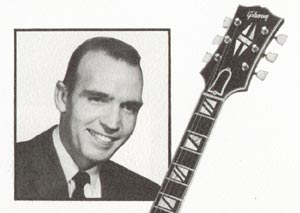
Johnny Smith was one of the legendary jazz guitarists to emerge from the late 1940s New York jazz scene, being made famous by tracks such as Moonlight in Vermont, which he recorded with Stan Getz.
His Gibson signature guitar became commercially available from 1961, with a single pickup initially, and an optional bridge pickup from 1963. The initial (June 1961) US price was $795 for a Sunburst example, or $810 for a Natural; the most expensive guitar in the 1961 Gibson price list. The model was initially called the 'Johnny Smith model' - this was until the two pickup version was launched in '63, when, to differentiate them, the guitars were given model codes JS and JSD. But the name Johnny Smith was always present in Gibson literature. This was until the June 1976 Gibson price list - from this point onwards, and in all Gibson catalogues, the model was simply referred to as JS / JSD.
Between 1961 and 1979, 963 single pickup (JS), and 625 double pickup (JS-D) Johnny Smith models were produced, with approximately 20% sporting a natural finish (JS-N, JS-DN), as opposed to the standard sunburst. Peak years were 1969, then 1968, with 177 and 165 instruments shipped respectively.
The neck pickup was not mounted into the guitars top, but was attached to the neck. Likewise controls and input jack are all mounted to the scratchplate.
“The J-S guitar's powerful Humbucking pickup is mounted to the neck of the instrument. This allows the acoustical body to resonate freely for a rich, full-bodied sound.”
Over the period of production, there were some small changes. Early examples (see the 1962 Gibson catalogue) had 22, or possibly 21 (see the 1964 catalogue), before settling on 20 for the rest of the course of production.
One other change made in 1978 was to the 'instant adjustment' jazz tailpiece - see images above.
This guitar was still being shipped as recently as 1989.
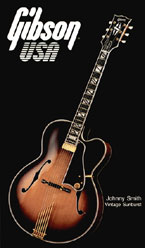
The following description is taken from the 1970 Gibson electric acoustics catalogue
JOHNNY SMITH-D - Artist Model. This Gibson artist model offers the finest in acoustical response and electronic amplification. Humbucking pickups and electronic controls are specially mounted to produce pure tones without restricting acoustic response.
FEATURES; Carved spruce top with bound "f" holes and matched figured maple rims, neck, and carved back. Slim, fast, low action neck joins body at 14th fret. Five piece curly maple neck with adjustable truss rod. Ebony fingerboard with pearl block inlays and nickel silver frets. Special ebony bridge with slanted ebony saddle. Volume control and instrument jack mounted on pickguard. Gold-plated metal parts and machine heads. 17" wide, 20 1/2" long, 3 1/8" deep; 25" scale, 20 frets.
JS-D double pickups - Sunburst finish
JS-DN double pickups - Natural finish
JS-single pickup - Sunburst finish
JS-N single pickup - Natural finish
Complete with plush-lined case and case cover
Electric guitar advertisements originally published from 1965 onwards. Click on the images for larger copies. Check out other vintage Gibson advertisements
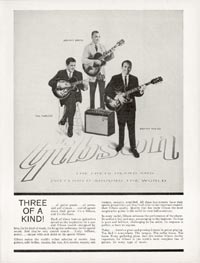
Gibson Johnny Smith - Three of a Kind (1965)
Advert for three Gibson Artist Acoustics; each being played by the jazz musician that gave it its name. Johnny Smith, Tal Farlow and Barney Kessel
Each of these famous guitarists served as...
[more]
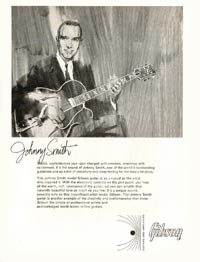
Gibson Johnny Smith - Johnny Smith (1966)
1966 illustration of Gibson artist Johnny Smith, with his similarly named electric acoustic guitar. Although unsigned, this picture is perhaps the work of Canadian illustrator (later fine artist) N...
[more]
After the models debut in 1961, the Gibson Johnny Smith guitar appeared in numerous Gibson catalogs. The dual pickup model was first included in the 1964 'Gibson Electrics' catalogue. In chronological order...
The 1962 Gibson electric guitar catalogue was the first to include the Johnny Smith guitar; part of the Electric Spanish artist series of high-end archtop jazz guitars. Only the single pickup model is listed
The 1964 Gibson electrics Catalog lists both the single and double pickup versions of the Johnny Smith guitar.
“This new artist's guitar offers the most perfect combination of acoustic response and electric amplification ever produced. An entirely new humbucking pickup and new method of mounting were designed to produce the purest tone amplification without restricting the acoustic response of the carved top”
From the 1966 Gibson electric guitar and bass catalogue
“A unique instrument to satisfy the most discriminating guitarist”
From the 1970 electric acoustics catalogue
“This Gibson Artist model offers the finest in acoustical response and electronic amplification. Humbucking pickups and electronic controls are specially mounted to produce pure tones without restricting acoustic response”
From the 1975 Gibson custom order and electric acoustics catalogue
“The J-S guitars powerful Humbucking pickup is mounted to the neck of the instrument. This allows the acoustical body to resonate freely for a rich, full-bodied sound”
The minimalist 1978 electrics catalogue entitled Quality / Prestige / Innovation
“This new artist's guitar offers the most perfect combination of acoustic response and electronic amplification ever produced. An entirely new humbucking pickup and new method of mounting were designed to produce tho purest tone amplification without restricting the acoustic response of the curved top”
The 1980 Gibson catalogue. In the 1978 and '79 catalogues the Johnny Smith is named JS for single pickup, and JSD for dual pickup guitars
This 1981 UK catalogue was produced by UK distributors Rosetti, and included the entire Gibson guitar line of the time
From the 1983 Gibson catalogue
“The Gibson Johnny Smith model is the namesake of one of the most extraordinary musicians of the 20th century. Slightly smaller than the L-5CES, the Johnny Smith (JS-D) utilizes a different system of bracing. The upper register of the neck is flush with the top and attaches to the soundboards interior bracing for optimum response and additional sustain. The top resonates freely. And the results are light action and sure response in a pure sounding guitar”
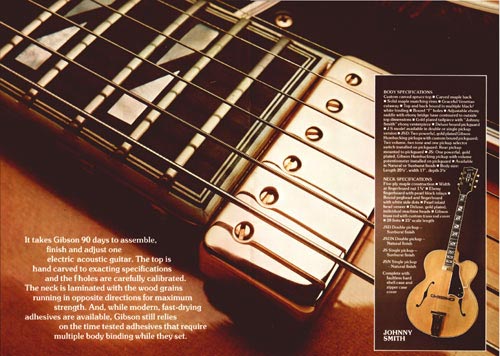
Gibson Johnny Smith as featured in the 1975 Gibson catalogue. This image shows how the neck humbucker is mounted onto the side of the guitar's neck, rather than into the carved top.
$12900
$12900
$9995
$16495
$2099
$1099
$695
$699
£1499